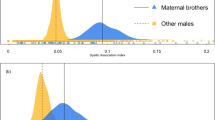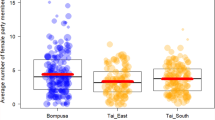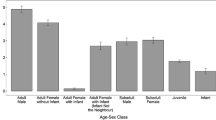Abstract
Although male–female relationships can offer a number of advantages such as protection or social support, they are poorly studied among primates compared to same-sex relationships. We used 12 yr of data from the Kanyawara chimpanzee community to compare three independent measures of association (party association, 5m association, and grooming) among all adult dyads. Party association exhibited by male–female dyads was of intermediate strength between strong male–male and weak female–female association. Male–female dyads were less likely to be within 5m of one another and to groom as male–male dyads, but equally likely to be within 5m and more likely to groom as female–female dyads. Variation in male–female association strength was not related to male rank but was affected by female ranging patterns and female reproductive states. Females with core areas in the center of the home range were more likely to be in parties with males but did not show higher spatial proximity or grooming indices compared to females ranging in the periphery. Party association and 5m indices were higher for dyads of males and estrous females compared to those with anestrous females. These results indicate that male–female dyads are likely to associate with one another more often than female–female dyads because of overlapping ranging patterns and short-term changes in female reproductive state. We conclude that male and female chimpanzees do not exhibit proximity and grooming patterns indicative of strong affiliative bonds. This study also highlights the importance of using multiple independent measures of bond strength in studies of primate social dynamics.



Similar content being viewed by others
References
Aureli, F., Schaffner, C. M., Boesch, C., Bearder, S. K., Call, J., Chapman, C. A., et al. (2008). Fission-fusion dynamics new research frameworks. Current Anthropology, 49, 627–654.
Cairns, S. J., & Schwager, S. J. (1987). A comparison of association indexes. Animal Behaviour, 35, 1454–1469.
Chapais, B. (1983). Adaptive aspects of social relationships among adult rhesus monkeys. In R. A. Hinde (Ed.), Primate social relationships: An integrated approach (pp. 286–289). Oxford: Blackwell.
Deschner, T., Heistermann, M., Hodges, K., & Boesch, C. (2004). Female sexual swelling size, timing of ovulation, and male behavior in wild West African chimpanzees. Hormones and Behavior, 46, 204–215.
de Vries, H. (1995). An improved test of linearity in dominance hierarchies containing unknown or tied relationships. Animal Behaviour, 50, 1375–1389.
de Vries, H., Netto, W. J., & Hanegraaf, P. L. H. (1993). Matman—A program for the analysis of sociometric matrices and behavioral transition matrices. Behaviour, 125, 157–175.
Duffy, K. G. (2006). Social dynamics of male chimpanzees: Adaptive significance of male bonds.Ph.D. thesis, University of California, Los Angeles.
Emery Thompson, M. (2005). Reproductive endocrinology of wild female chimpanzees (Pan troglodytes schweinfurthii): Methodological considerations and the role of hormones in sex and conception. American Journal of Primatology, 67, 137–158.
Emery Thompson, M., Kahlenberg, S. M., Gilby, I. C., & Wrangham, R. W. (2007). Core area quality is associated with variance in reproductive success among female chimpanzees at Kanyawara, Kibale National Park. Animal Behaviour, 73, 501–512.
Emery Thompson, M., & Wrangham, R. W. (2008). Male mating interest varies with female fecundity in Pan troglodytes of Kanyawara, Kibale National Park. International Journalof Primatology, 29, 885–905.
Furuichi, T. (2011). Female contributions to the peaceful nature of bonobo society. Evolutionary Anthropology, 20(4), 131–142.
Gilby, I. C., Brent, L. J. N., Wroblewski, E. E., Rudicell, R. S., Hahn, B. H., Goodall, J., & Pusey, A. E. (2013). Fitness benefits of coalitionary aggression in male chimpanzees. Behavioral Ecology and Sociobiology, 67(3), 373–381.
Gilby, I. C., & Wrangham, R. W. (2008). Association patterns among wild chimpanzees (Pantroglodytes schweinfurthii) reflect sex differences in cooperation. Behavioral Ecologyand Sociobiology, 62(11), 1831–1842.
Goodall, J. (1986). The chimpanzees of Gombe: Patterns of behavior. Cambridge, MA: Belknap Press.
Hohmann, G., Gerloff, U., Tautz, D., & Fruth, B. (1999). Social bonds and genetic ties: Kinship association and affiliation in a community of bonobos (Pan paniscus). Behaviour, 136, 1219–1235.
Izar, P. (2004). Female social relationships of Cebus apella nigritus in a southeastern Atlantic Forest: An analysis through ecological models of primate social evolution. Behaviour, 141, 71–99.
Janson, C. H. (1985). Aggressive competition and individual food consumption in wild brown capuchin monkeys (Cebus apella). Behavioral Ecology and Sociobiology, 18, 125–138.
Janson, C. H. (1990a). Ecological consequences of individual spatial choice in foraging groups of brown capuchin monkeys, Cebus apella. Animal Behaviour, 40, 922–934.
Janson, C. H. (1990b). Social correlates of individual spatial choice in foraging groups of brown capuchin monkeys, Cebus apella. Animal Behaviour, 40, 910–921.
Kahlenberg, S. M., Emery Thompson, M., & Muller, M. N. (2008a). Immigration costs for female chimpanzees and male protection as an immigrant counterstrategy to intrasexual aggression. Animal Behaviour, 76, 1497–1509.
Kahlenberg, S. M., Emery Thompson, M., & Wrangham, R. W. (2008b). Female competition over core areas in Pan troglodytesschweinfurthii, Kibale National Park, Uganda. International Journal of Primatology, 29(4), 931–947.
Kano, T. (1992). The last ape : Pygmy chimpanzee behavior and ecology. Stanford, CA: Stanford University Press.
Langergraber, K., Mitani, J., & Vigilant, L. (2009). Kinship and social bonds in female chimpanzees (Pan troglodytes). American Journal of Primatology, 71(10), 840–851.
Langergraber, K. E., Mitani, J. C., & Vigilant, L. (2007). The limited impact of kinship on cooperation in wild chimpanzees. Proceedings of the National Academy of Sciences of the USA, 104(19), 7786–7790.
Langergraber, K. E., Mitani, J. C., Watts, D. P., & Vigilant, L. (2013). Male-female socio-spatial relationships and reproduction in wild chimpanzees. Behavioral Ecology and Sociobiology, 67, 861–873.
Lehmann, J., & Boesch, C. (2005). Bisexually bonded ranging in chimpanzees (Pan troglodytes verus). Behavioral Ecology and Sociobiology, 57(6), 525–535.
Lehmann, J., & Boesch, C. (2008). Sexual differences in chimpanzee sociality. International Journal of Primatology, 29(1), 65–81.
Lehmann, J., & Boesch, C. (2009). Sociality of the dispersing sex: The nature of social bonds in West African female chimpanzees, Pan troglodytes. Animal Behaviour, 77(2), 377–387.
Matsumoto-Oda, A. (2002). Social relationships between cycling females and adult males in Mahale chimpanzees. In C. Boesch, G. Hohmann, & L. F. Marchant (Eds.), Behaviouraldiversity in chimpanzees and bonobos (pp. 168–180). Cambridge, U.K: Cambridge University Press.
Matsumoto-Oda, A., Hosaka, K., Huffman, M. A., & Kawanaka, K. (1998). Factors affecting party size in chimpanzees of the Mahale mountains. International Journal of Primatology, 19(6), 999–1011.
Matsumoto-Oda, A., & Oda, R. (1998). Changes in the activity budget of cycling female chimpanzees. American Journal ofPrimatology, 46, 157–166.
Maynard Smith, J. (1977). Parental investment—prospective analysis. Animal Behaviour, 25, 1–9.
Mitani, J. C. (2009). Male chimpanzees form enduring and equitable social bonds. AnimalBehaviour, 77(3), 633–640.
Muller, M. N. (2002). Agonistic relations among Kanyawara chimpanzees. In C. Boesch, G. Hohmann, & L. F. Marchant (Eds.), Behavioural diversity in chimpanzees and bonobos (pp. 112–124). Cambridge: Cambridge University Press.
Muller, M. N., Kahlenberg, S., & Wrangham, R. (2009). Male aggression against females and sexual coercion in chimpanzees. In M. Muller & R. Wrangham (Eds.), Sexual coercion in primates: An evolutionary perspective on male aggression against females (pp. 184–217). Cambridge, MA: Harvard University Press.
Muller, M. N., Kahlenberg, S. M., Emery Thompson, M., & Wrangham, R. W. (2007). Male coercion and the costs of promiscuous mating for female chimpanzees. Proceedings of the Royal Society of London B: Biological Sciences, 274, 1009–1014.
Muller, M. N., & Mitani, J. (2005). Conflict and cooperation in wold chimpanzees. Advances in the Study of Behavior, 35, 275–331.
Newton-Fisher, N. (2002). Male chimpanzee relationships in the Budongo Forest, Uganda. In C. Boesch, G. Hohmann, & L. F. Marchant (Eds.), Behavioural diversity in chimpanzees in bonobos (pp. 125–137). Cambridge, U.K: Cambridge University Press.
Newton-Fisher, N. E., Thompson, M. E., Reynolds, V., Boesch, C., & Vigilant, L. (2010). Paternity and social rank in wild chimpanzees (Pan troglodytes) from the Budongo Forest, Uganda. American Journal of Physical Anthropology, 142(3), 417–428.
Otali, E., & Gilchrist, J. S. (2006). Why chimpanzee (Pan troglodytes schweinfurthii) mothers are less gregarious than nonmothers and males: The infant safety hypothesis. Behavioral Ecology and Sociobiology, 59(4), 561–570.
Palombit, R. A. (2000). Infanticide and the evolution of male-female bonds in animals. In C. P. van Schaik & C. H. Janson (Eds.), Infanticide by males and its implications (pp. 239–292). Cambridge, U.K: Cambridge University Press.
Palombit, R. A. (2009). Friendships with males: A female counterstrategy to infanticide in the Okavango chacma baboons. In M. N. Muller & R. W. Wrangham (Eds.), Sexual coercion in primates and humans: An evolutionary perspective on male aggression against females (pp. 377–409). Cambridge, MA: Harvard University Press.
Pandolfi, S. S. (2004). Ecological sex differences in Gombe chimpanzees (Pan troglodytes). Ph.D. thesis, Duke University.
Pereira, M. E., & Kappeler, P. M. (1997). Divergent systems of agonistic behaviour in lemurid primates. Behaviour, 134, 225–274.
Pereira, M. E., & McGlynn, C. A. (1997). Special relationships instead of female dominance for redfronted lemurs, Eulemur fulvus rufus. American Journal of Primatology, 43(3), 239–258.
Perry, S. (1997). Male-female social relationships in wild white-faced capuchins (Cebus capucinus). Behaviour, 134, 477–510.
Pieta, K. (2008). Female mate preferences among Pan troglodytes schweinfurthii of Kanyawara, Kibale National Park, Uganda. International Journal of Primatology, 29(4), 845–864.
Pusey, A., Murray, C., Wallauer, W., Wilson, M., Wroblewski, E., & Goodall, J. (2008). Severe aggression among female Pan troglodytes schweinfurthii at Gombe National Park, Tanzania. International Journal of Primatology, 29(4), 949–973.
Pusey, A. E. (1987). Sex-biased dispersal and inbreeding avoidance in birds and mammals. Trends in Ecology & Evolution, 2(10), 295–299.
Slater, K. Y., Schaffner, C. M., & Aureli, F. (2009). Sex differences in the social behavior of wild spider monkeys (Ateles geoffroyi yucatanensis). American Journal of Primatology, 71(1), 21–29.
Smuts, B. (1992). Male aggression against women: An evolutionary perspective. Human Nature, 3(1), 1–44.
Smuts, B. B. (1985). Sex and friendship in baboons. New York: Aldine.
Sterck, E. H. M., Watts, D. P., & van Schaik, C. P. (1997). The evolution of female social relationships in nonhuman primates. Behavioral Ecology & Sociobiology, 41, 291–309.
Stumpf, R. M., & Boesch, C. (2006). The efficacy of female choice in chimpanzees of the Tai Forest, Cote d'Ivoire. Behavioral Ecology and Sociobiology, 60(6), 749–765.
Sugiyama, Y. (1968). Social organization of chimpanzees in the Budongo Forest, Uganda. Primates, 9, 225–258.
Surbeck, M., Deschner, T., Schubert, G., Weltring, A., & Hohmann, G. (2012). Mate competition, testosterone and intersexual relationships in bonobos, Pan paniscus. AnimalBehaviour, 83(3), 659–669.
Surbeck, M., Mundry, R., & Hohmann, G. (2011). Mothers matter! Maternal support, dominance status and mating success in male bonobos (Pan paniscus). Proceedings of the Royal Societyof London B: Biological Sciences, 278(1705), 590–598.
Symington, M. M. (1987). Sex-ratio and maternal rank in wild spider monkeys—When daughters disperse. Behavioral Ecology and Sociobiology, 20(6), 421–425.
Takahata, Y. (1982). Social relationships between adult males and females of Japanese monkeys in the Arashiyama B Troop. Primates, 23(1), 1–23.
Trivers, R. L. (1972). Parental investment and sexual selection. In B. Campbell (Ed.), Sexual selection and the descent of man: 1871–1971 (pp. 136–179). Chicago: Aldine.
Tutin, C. E. G. (1979). Mating patterns and reproductive strategies in a community of wild chimpanzees (Pan troglodytes schweinfurthii). Behavioral Ecology and Sociobiology, 6(1), 29–38.
van Noordwijk, M. A., & van Schaik, C. P. (2004). Sexual selection and the careers of primate males: Paternity concentration, dominance acquisition tactics and transfer decisions. In P. M. Kappeler & C. P. van Schaik (Eds.), Sexual selection in primates: A comparative perspective (pp. 208–229). Cambridge, U.K: Cambridge University Press.
van Schaik, C. P., & Kappeler, P. M. (1997). Infanticide risk and the evolution of male-female association in primates. Proceedings of the Royal Society of London B: Biological Sciences, 264(1388), 1687–1694.
Wakefield, M. L. (2013). Social dynamics among females and their influence on social structure in an East African chimpanzee community. Animal Behaviour, 85, 1303–1313.
Wakefield, M. L. (2008). Grouping patterns and competition among female Pan troglodytesschweinfurthii at Ngogo, Kibale National Park, Uganda. International Journal of Primatology, 29(4), 907–929.
Watts, D. P. (1992). Social relationships of immigrant and resident female mountain gorillas. 1. Male-female relationships. American Journal of Primatology, 28(3), 159–181.
Watts, D. P. (2000). Grooming between male chimpanzees at Ngogo, Kibale National Park. II. Influence of male rank and possible competition for partners. International Journal of Primatology, 21(2), 211–238.
Watts, D. P. (2007). Effects of male group size, parity, and cycle stage on female chimpanzee copulation rates at Ngogo, Kibale National Park, Uganda. Primates, 48(3), 222–231.
Williams, J. M., Liu, H.-Y., & Pusey, A. E. (2002). Costs and benefits of grouping for female chimpanzees at Gombe. In C. Boesch, G. Hohmann, & L. F. Marchant (Eds.), Behavioural diversity in chimpanzees and bonobos (pp. 192–203). Cambridge: Cambridge University Press.
Wilson, M. L., Kahlenberg, S. M., Wells, M., & Wrangham, R. W. (2012). Ecological and social factors affect the occurrence and outcomes of intergroup encounters in chimpanzees. Animal Behaviour, 83, 277–291.
Wittig, R. M., & Boesch, C. (2005). How to repair relationships—Reconciliation in wild chimpanzees (Pan troglodytes). Ethology, 111(8), 736–763.
Wrangham, R. W. (2000a). Why are male chimpanzees more gregarious than mothers? A scramble competition hypothesis. In P. Kappeler (Ed.), Male primates (pp. 248–258). Cambridge, U.K: Cambridge University Press.
Wrangham, R. W. (2000b). Why are male chimpanzees more gregarious than mothers? A scramble competition hypothesis. In P. M. Kappeler (Ed.), Primate males: Causes and consequences of variation in group composition (pp. 248–258). Cambridge, U.K: Cambridge University Press.
Wrangham, R. W., & Smuts, B. (1980). Sex differences in the behavioral ecology of chimpanzees in the Gombe National Park, Tanzania. Journal of Reproduction and Fertility (Supplement), 28, 13–31.
Wroblewski, E. E., Murray, C. M., Keele, B. F., Schumacher-Stankey, J. C., Hahn, B. H., & Pusey, A. E. (2009). Male dominance rank and reproductive success in chimpanzees, Pantroglodytes schweinfurthii. Animal Behaviour, 77(4), 873–885.
Acknowledgments
This research was funded by Harvard University, NSF grants 0416125 and 0849380 (to R. W. Wrangham) and by a Wenner–Gren Hunt Fellowship (to Z. P. Machanda). We thank the Uganda National Council for Science and Technology, the Uganda Wildlife Authority, and the Makerere Biological Field Station for permission to conduct research within Kibale National Park. This research complies with the current laws of Uganda. This project would not have been possible without the hard work and dedication of the field research team, especially Francis Mugurusi, Christopher Muruuli, Peter Tuhairwe, Christopher Katongole, James Kyomuhendo, Solomon Musana, Sunday John, Wilberforce Tweheyo, Edgar Mugenyi, and the late Donor Muhangyi and John Barwogeza as well as field managers Michael Wilson, Martin Muller, Katherin Pieta, Carole Hooven, Kimberly Duffy, Alain Houle, and Emily Otali. Martin Muller and Melissa Emery Thompson provided useful comments on earlier versions of this manuscript. We also thank the editor and two anonymous reviewers for their feedback.
Author information
Authors and Affiliations
Corresponding author
Rights and permissions
About this article
Cite this article
Machanda, Z.P., Gilby, I.C. & Wrangham, R.W. Male–Female Association Patterns Among Free-ranging Chimpanzees (Pan troglodytes schweinfurthii). Int J Primatol 34, 917–938 (2013). https://doi.org/10.1007/s10764-013-9707-7
Received:
Accepted:
Published:
Issue Date:
DOI: https://doi.org/10.1007/s10764-013-9707-7




